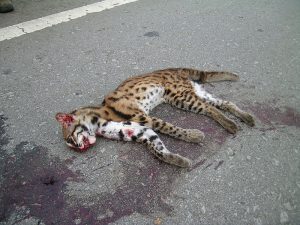Leopard cats and roads
The leopard cat is second on the list of “endangered animals killed on the road” in Peninsular Malaysia in the first nine months of 2017. Fourteen leopard cats succumbed during that period according to the Ministry of Natural Resources and Environment in a statement that was reported by Channel News Asia.
Other species killed include Malayan tapir, elephant, binturong and leopard.
Malaysia’s Department of Wildlife and National Parks (PERHILITAN) has since put up warning signs for motorists, is in talks with driving schools to improve drivers’ awareness, and are avocating more wildlife-friendly viaduct crossings to be built at road developments.
Based on a recently published study (Laton et al.), most leopard cat roadkills seem to be on tarmac roads adjacent to areas where there are secondary forest and plantations.
One reason for this is that leopard cats, like many carnivorans, seem to be fond of roads near forested areas. Perhaps this is because it is easier to travel, find, and catch prey along roads. However, this put them right in harms way, and many end up as roadkill.
Road mortality is not just a problem for the leopard cat but also wildlife in general. But it is an issue that can only be effectively solved with multiple decision makers. Signs in Singapore and Malaysia show that this is coming together. Hopefully, with sound science-based decisions for policy planning and roadkill mitigation, wildlife roadkills would not exacerbate the ongoing biodiversity crisis in Southeast Asia.
Laton, M.Z., Mohammed, A.A., Yunus, H. 2017. Roadkill incidents of the leopard cat (Prionailurus bengalensis) in the exterior wildlife reserved: A selected plantation area case. Journal of Entomological and Zoology Studies 5(4): 1507-1513.

